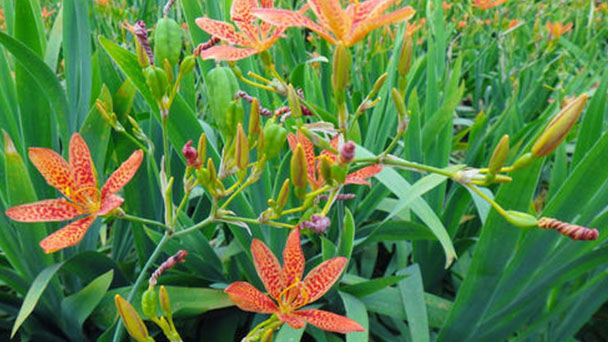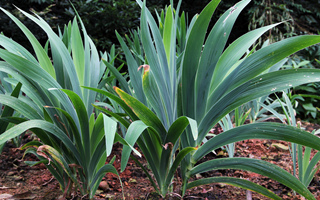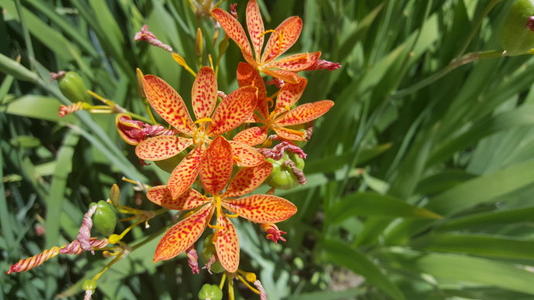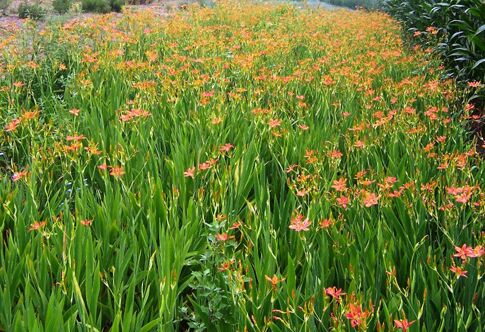Blackberry Lily (Iris Domestica) Profile
Written by admin
Apr 08 2023

Blackberry lily (Belamcanda chinensis (L.) Redoute), also known as leopard lily, is an erect perennial herb.
Blackberry Lily Picture

Blackberry Lily Info
| Botanical Name | Iris domestica |
| Common Names | Blackberry lily; leopard lily |
| Plant Type | Herbaceous perennial |
| Size |
2–3 feet tall, 9–24 inches wide Bloom time |
| Bloom time | Mid to late summer |
| Sun | Full sun |
| Flower color | Orange with red spots |
| Toxicity | Mildly toxic to humans and animals |
Morphological Characteristics of Blackberry Lily
Leaf
The leaves of blackberry lily are alternate, imbricate, sword-shaped, 20-60 cm long, 2-4 cm wide, the base of which is scabbily operculate, the top of which is acutely acute, without midrib.
Flowers
Blackberry lily has terminal inflorescences with forked branches, and several flowers gather at the top of each branch. Pedicels are thin, ca. 1.5 cm long; Pedicels and inflorescences branched with membranous bracts, bracts lanceolate or ovoid; Flowers are orange-red, scattered purple-brown spots, 4-5 cm in diameter; Perianth lobes of blackberry lily are in 6, 2-wheeled rows, outer perianth lobes obovate or oblong, ca. 2.5 cm long and ca. 1 cm wide, apex obtuse or concave, base cuneate, inner perianth lobes slightly shorter and narrower than outer perianth lobes; Blackberry lily has 3 stamens, 1.8 -- 2 cm long, attached to the base of outer perianth lobes, anthers striate, outward dehiscent, filaments subcylindrical, base slightly flat and broad; Style is distally slightly oblate, apically 3-lobed, lobes marginally curling outward, with fine short hairs, ovary inferior, obovate, 3-locule, axial placenta, ovules numerous.
Fruit
Capsule of Blackberry Lily: obovate or oblong, yellowish-green, 2.5 -- 3 cm long, 1.5 -- 2.5 cm in diameter, unbeaked at the top, often with a wilting perianth, locularis dehiscent at maturity, fruit petals valgus, with an erect axis in the center; Seeds of blackberry lily are globose, dark purple, lustrous, ca. 5 mm in diam., borne on fruit axis.
The Ecological Habits of Blackberry Lily
Blackberry Lily grows at the edge of forests or grasslands on hillsides, and most of them grow at low elevations. However, it can also grow at an altitude of 2000-2200 meters in southwest mountainous areas.
Blackberry Lily likes warmth and sunshine, is resistant to drought and cold, and is not strict in soil requirements. blackberry lily can be cultivated on dry land on hillsides, so as to be fertile and loose. The sandy loam with higher terrain and good drainage is preferable. Neutral loam or slightly alkaline soil is suitable, avoid low-lying land and saline-alkali land.
How to Grow and Care for Blackberry Lily
Temperature
Warmth is most suitable for blackberry lily, can always be maintained between 15 and 28 degrees. In addition, because its ability to withstand cold is relatively strong, so the winter generally does not take special measures, except in the very north of the region. However, the temperature as far as possible not too high, will affect its growth to a certain extent.
Light
blackberry lily likes light, so needs to provide good sunshine. When it is growing at its fastest rate, try to keep enough light to meet its requirements. However, in the summer, try to get a little shade, especially at noon.
Watering
blackberry lily is not waterlogging resistant. Therefore, not only can not water too much at ordinary times, resulting in water, in the plum rain or other rain time but also pay attention to timely drainage.
Fertilization
In order to promote blackberry lily grow well, the right amount of fertilizer is indispensable. Generally speaking, the season for top dressing is in March and June. In addition, before entering the winter, a certain amount of fertilizer can be mixed into the soil.
Pruning
The first is to top, so that the nutrients can concentrate on its roots and stems, effectively improve the yield of about 10 percent. And when its leaves wither, blackberry lily needs to be cut off in time, which is also to avoid consuming too many nutrients.
Potting and Repotting Blackberry Lily
Growing blackberry lilies in containers is a great way to "stage" the plants when they come into bloom: Before blooming, place the containers in an out-of-the-way spot, as the foliage is not much to look at. When the blooms begin, move the containers to a prominent spot on the porch or patio where you can enjoy the flowers.
Plant up two or three blackberry lilies in the same pot to give a full look. Use well-drained potting soil. Arrange the rhizomes close to the soil's surface so that they are not touching. Divide and repot the lilies as they expand and become crowded. Repot in late summer, when growth slows down.
In cold climates (freezing temperatures and snowfall), the dormant plants in their pots can usually be stored in a sheltered but cool area for the winter. Zone 5 gardeners, however, may find that potted blackberry lilies perish over the winter unless moved into a garage or basement.
Growing Blackberry Lily from Seed
Blackberry Lily propagates from seeds and roots. The production cycle of seed propagation was long, but the propagation coefficient was high. Rhizome propagation results in the early harvest and quick effect, but the propagation coefficient is low, and long-term planting will lead to germplasm degradation. Therefore, the two methods should be used alternately in production. Use rhizome to propagate more, because propagate fast, also can use the seed to propagate.

How to Propagate Blackberry Lily
Similar to the way that iris or daylily rhizomes can be divided, you can propagate blackberry lilies in the same way—by digging and dividing the root clumps. This is best done when the flowering is over and the plants are mostly done growing. Dig up plants, and use a sharp knife to cut apart pieces that have a fan of foliage attached. Replant them in the desired locations at the same depth.
Periodic division is also a good time to inspect the roots for borers and cut away any diseased or rotting sections.
Disease Control of Blackberry Lily
Disease Control
Disease control and pest control: the main disease in the seedling period is rust.
Prevention and control measures: First, increase the application of phosphorus and potassium fertilizer, improve the resistance; Two is the onset of early spray 15% powder rust would rather wet powder 1000 ~ 1500 times diluent or 12.5% Wo Wet powder 3000 times liquid, every 7 ~ 10 days spray 1 time, even spray 2 ~ 3 times.
It occurs in both seedlings and adult blackberry lily, but the adult plant occurs early, harms the leaves in autumn, and shows brown ridges.
Prevention and control method: spray 95% antirust sodium 400 times liquid at the beginning, every 7 ~ 10 days to play 1 time, 2 ~ 3 times in a row.
Disease control and pest control: the diseases of Blackberry Lily in the growing period include root rot, rust, leaf spot, Mosaic disease, etc.
Prevention and control measures of root rot: pull out the diseased plants, disinfect soil with lime powder in the diseased holes and areas, and spray the plants with Bordeaux liquid.
Prevention and control methods of rust: at the beginning of the disease with powder rust ning, Dai Sen zinc and other liquid prevention and control.
The prevention and control method of leaf spot disease: before the disease with Bordeaux liquid prevention, when the disease with carbendazim spray plant.
Mosaic disease prevention and control measures: pay attention to the prevention and control of aphids, opponents, knives and other disinfection.
Pest Control
The pests during the growth period of Blackberry Lily include yellow spot weed moth, large gray weevils, large green leaf cicada, citrus man shack scale, ground tiger, grubs, mole cricket, cordera, etc.
Prevention and control measures of yellow spot poisonous moth: artificial cocoon, eliminate the eggs. The prevention and control measures of the gray weevil: irrigate the damaged plot when the adult weevil occurred in spring; Dig insect-proof trenches 50 cm deep at the four sides of the ground. The prevention and control measures of the cicada: use light to trap and kill the adult, or catch the adult when it is not active in the morning.
The control measures of the citrus dwarf scale were as follows: destroying the insect strains; Spray 3% acetamprid 2000 ~ 2500 times solution or 48% Lesbon emulsion 1000 times solution once every 7 ~ 10 days for 3 times.
The prevention and control measures of the ground tiger: medium plowing and weeding; Artificial capture; With 90% crystal trichlorfon 800 ~ 1000 times the liquid irrigation, with poison bait, light, such as dung kill.
The control measures of white grubs are as follows: they can be killed by poison bait, light and dung. The water was irrigated with 25% parathion microcapsule 500 ~ 800 times liquid.
The prevention and cure method of mole cricket: reasonable irrigation, prevent and cure with poison valley.
The control method of diamondworm: spray 4.5% cypermethrin 3000 times solution before damaging leaf sheath in June.
Classification of Blackberry Lily Varieties
Irides
Monocotyledons a family of the subclass Liliforma. Herbs perennial or 1-year-old. Having a rhizome, corm, or bulb; All are fibrous roots. Leaves are striate, sword or filiform, veins parallel, base sheathlike, compressed on both sides, superimposed. Flowers are solitary or raceme, spike, cyme, or panicle; Flowers are bisexual, brightly colored, actinomorphic or bilateral; Perianth segments 6, arranged in two circles, base united into perianth tubes;
The common ornamental plants are gladiolus, tiger flower, Avalokitesvara, Avalokitesvara, realgar orchid, iris, iris, etc., and the representative species are:
Iris
It is produced in the eastern, central, southwest and northwest provinces of China. North Korea, the former Soviet Union, Japan. Leaves are basal, broad sword-shaped, yellow-green. Flowers are large, blue-purple, outer perianth segments 3, broadly ovate, with corn-like appendages on midveins, inner perianth segments 3, elliptic, spreading outward when in bloom; Stamens 3, anthers outward dehiscent; Styles branched 3, flattened, petalate, ovary inferior, fusiform cylindrical. Capsule long elliptic or obovate.Rhizoma medicine, anti-inflammatory analgesic, digestion and liver protection effect.Large and beautiful flowers, cultivation for ornamental.
Marin
It is found in Northeast, North, Central China, Sichuan, Xizang and other provinces. North Korea, the former Soviet Union, India and other countries have it.
Saffron
Originating in southern Europe, it has been cultivated in China. Herbs perennial. Corm oblate globose, outsourced with yellowish-brown membranous envelope. Leaves are basal, striate, grayish-green, margin rebounding; The flower stem is very short and does not protrude from the surface.
The Distribution Area of Blackberry Lily
Blackberry Lily is distributed in tropical, subtropical and temperate regions all over the world, with its distribution center in southern Africa and tropical America. Blackberry lily is produced in Jilin, Liaoning, Hebei, Shanxi, Shandong, Henan, Anhui, Jiangsu, Zhejiang, Fujian, Taiwan, Hubei, Hunan, Jiangxi, Guangdong, Guangxi, Shaanxi, Gansu, Sichuan, Guizhou, Yunnan, Xizang. Blackberry lily is also found in Korea, Japan, India, Vietnam, and the Soviet Union.
Blackberry Lily Toxicity
All species of Iris are considered class 2 (minor toxins causing stomach and intestinal upset) and class 4 toxins (causing dermatitis reactions) for humans, according to official lists of poisonous plants. These plants are somewhat more toxic to dogs, cats, and other animals. The primary toxins are thought to be irisin and certain pentacyclic terpenoids.
Poisoning in humans is more common than you might think since this plant has a long history of being used in folk medicine. People who consume the plant in this way without training may experience stomach upset.
Symptoms of Poisoning
In humans, consumption of plant parts, especially the roots, can cause diarrhea and vomiting. The plant is somewhat more toxic to animals, where ulcers of the stomach and small intestine have been known to occur. Though most symptoms are relatively minor and temporary, a seriously ill pet should be brought to a veterinarian. Treatment may include induced vomiting, and treatment with activated charcoal to absorb the toxins. Most often, though, symptoms are mild and quite temporary.
The Use of Blackberry Lily in Gardens
Blackberry lily has an elegant flower shape, interesting, suitable for making flower path.

Latest Updated
- Blackberry Lily (Iris Domestica) Profile
- How to Propagate Blackberry
- How to Prune Cilantro - Should I Cut Them After It Flowers?
- How to Grow Cilantro?
- Boysenberry vs. Blackberry - Are They The Same Thing
- Can Java Moss Grow Out Of Water - How to Make It Possible
- How Fast Does Java Moss Grow - How to Make It Grow Fast
- How to Grow & Care for Java Moss
- How to Remove Moss from Your Roof - Quick & Safe Methods
- Lichens vs. Mosses - Differences & How Do You Identify
Popular Articles
- Winter maintenance of Antirrhinum Majus
- How to Grow Terminalia Mantaly Tree
- How to Grow and Care for Crossostephium Chinense
- How to grow Antirrhinum Majus in spring
- Peristeria Elata (Dove Orchid) Profile: Info & Care Guide
- How to Care for Brazilian Jasmine Plant (Mandevilla Sanderi)
- Underwatered Snake Plant (Sansevieria Trifasciata) - Signs And How To Fix
- Rosa Chinensis (China Rose): Plant Growing & Care Tips
- How to Grow & Care for Graptopetalum Purple Delight in Summer
- How to Care for Baby Sun Rose (Aptenia Cordifolia)